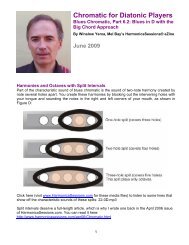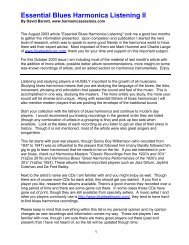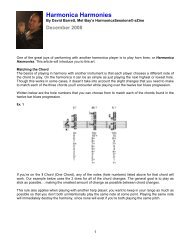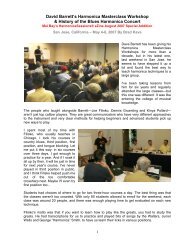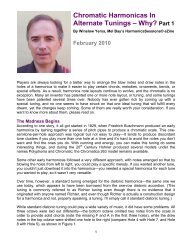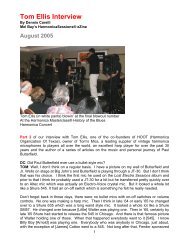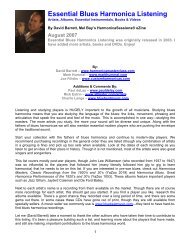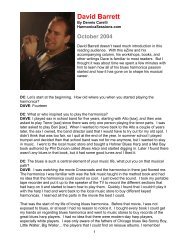Tom Ellis Interview - Mel Bay's Harmonica Sessions
Tom Ellis Interview - Mel Bay's Harmonica Sessions
Tom Ellis Interview - Mel Bay's Harmonica Sessions
You also want an ePaper? Increase the reach of your titles
YUMPU automatically turns print PDFs into web optimized ePapers that Google loves.
<strong>Tom</strong> <strong>Ellis</strong> <strong>Interview</strong><br />
by Dennis Carelli<br />
<strong>Tom</strong> <strong>Ellis</strong> (in white pants) blowin' at the final blowout number<br />
At the <strong>Harmonica</strong> Masterclass® History of the Blues<br />
<strong>Harmonica</strong> Concert<br />
Part 1 - The Start: Iron Butterfly, Microphones, and of the love for Paul Butterfield<br />
<strong>Tom</strong> <strong>Ellis</strong>, one of the co-founders of HOOT (<strong>Harmonica</strong> Organization Of Texas), has<br />
been playing harmonica for over 30 years. From bluegrass music, to rock and finally to<br />
the blues inspired from hearing the legendary Paul Butterfield, <strong>Tom</strong> has been involved<br />
with the harmonica and his love of music in many forms: as a player in various groups; as<br />
a student studying with Jerry Portnoy; and as a teacher teaching a program that helps<br />
establish the key elements to become a good harmonica player. He is known to many as<br />
the owner of <strong>Tom</strong>'s Mics, a leading supplier of vintage harmonica microphones to players<br />
all over the world including many professional players. To many more harp players he is<br />
thought of as a well known and knowledgeable writer who authored a series of articles<br />
published in the late 1990's about the music and personal journey of Paul Butterfield, the<br />
harp player that forever influenced <strong>Tom</strong> and countless others.<br />
DC: Let's start at the beginning. Tell me, how did you get involved in music and<br />
particularly how did you get involved with the harmonica?<br />
TOM: Well, I don't come from a musical family but my dad was a pretty big "jazz<br />
hound." So when I was growing up I was introduced to everybody from Frank Sinatra to<br />
<strong>Mel</strong> Torme, from Tony Bennett to Carmen McRae. I probably heard all the great jazz<br />
singers when I was growing up. When I was about sixteen, the summer I turned sixteen
actually, a friend of time who I was working with at the time had gone to San Francisco<br />
and brought me back a copy of one of the very first issues of Rolling Stone magazine.<br />
There was story in that issue about [Paul] Butterfield. I read that story and was pretty<br />
intrigued. I had never listened to blues prior to that time. I had grown up in a beach in<br />
Florida with the Beach Boys and the pop music. There was a DJ who was running a small<br />
AM station in the beach community where I grew up who was playing a lot of the mid-<br />
1960's rock sound. He was playing everything from Quicksilver [Messenger Service] to<br />
Janis Joplin to Steve Miller to a lot of Lovin' Spoonful and the Byrds. All that music that<br />
was coming out around then. Kind of an alternative approach to [radio] programming at<br />
the time. So I was hearing a lot of that music, but I hadn't heard any blues. So this issue<br />
of Rolling Stone intrigued me because there were some things I didn't know. I knew the<br />
names of the groups and I had heard some of their music. And I actually went out not<br />
long after that and bought a copy of the first Butterfield album. And that is what<br />
introduced me to basically everything. And from that album I think the next thing I<br />
bought was probably "Stand Back" by Charlie [Musselwhite]. And then after that I just<br />
started haunting some record stores and buying up all the Chess [Records] stuff I could. I<br />
can remember the first Little Walter album I got, the [James] Cotton stuff on Verve<br />
[Records]. And I just kind of jumped into it from that point forward.<br />
DC: But at that time were you playing harmonica or just getting into the music?<br />
TOM: Well, no I wasn't playing harmonica. I didn't start playing harmonica until late in<br />
my sixteenth year. Actually, one of my closest friends in Florida where I grew up, his<br />
mother had been a very successful jazz singer in San Francisco after World War II. So we<br />
would hang out at his house a lot. He was a really good guitar player. And another one of<br />
my closest friends was a drummer. They had a group together and I was always trying to<br />
figure out a way to wiggle my way in. I can't remember where I saw this picture of<br />
Butterfield, it might have been in Rolling Stone. But there was this picture of Butterfield<br />
back around that time and he was holding a Koch [harmonica]. You know one of the little<br />
ten-hole diatonic tuned harmonicas that looks like a Chromatic. And I bought one of<br />
those things because I was so intrigued with his music. I spent the next year incredibly<br />
frustrated, unable to figure out exactly how he was able to get the sounds he got out of<br />
that Koch ten-hole harmonica. About that time, right around when I was mid-seventeen<br />
or eighteen, I discovered Tony Glover's book by accident in a music store. And kind of<br />
opened a lot of doors and helped me figure stuff out. And from that point forward I was<br />
playing regularly in what you would call rock 'n roll bands. Although by this time, '68/'69<br />
we'd integrated a lot of stuff. The Allman Brothers are from where I grew up [in Florida].<br />
You heard that and you heard a lot of the early Jay Geils Band stuff we were into. They<br />
were on the set list. And the band I played with when I went to college, the drummer had<br />
played with the Allman Brothers in Dayton Beach when they were the Allman Joys. And<br />
the guitar player had played with Ted Nugent, believe it or not. He was a bass payer then<br />
and had played in the original Amboy Dukes. Both those guys were pretty tuned into<br />
blues so we did a lot of blues music. Of course we also did a lot of Iron Butterfly. We<br />
crossed a lot of music types. I was playing out pretty regularly by the time I was eighteen
or nineteen. In the summers when I wasn't in college I played in a blue grass band. And I<br />
played harp almost exclusively in that ensemble. It was banjo, guitar, bass and<br />
harmonica. And my brother would sometimes play guitar and I would play bass with<br />
them. So I was going back and forth between bluegrass and blues regularly.<br />
DC: Playing as much as possible.<br />
TOM: Yeah. During the summer we did the folk festival circuit in the southeast which<br />
still exists. And we would go out on the road in the summer for the better part of two<br />
months. We could go out and play the folk festival circuit. And I got introduced there to a<br />
lot of what I would call country blues and Piedmont blues. I heard a lot of those kind of<br />
guys like Sonny Terry and all those guys. So I got exposed to a whole different slice of<br />
blues that I was listening to in my record collection.<br />
DC: I'm still trying to digest the idea of In-A-Gadda-Da-Vida on harmonica<br />
TOM: (Laughs) No we didn't play In-A-Gadda-Da-Vida on harmonica. I sang. I was<br />
basically the lead singer in all the bands except the bluegrass band. I sang the tenor<br />
harmony parts in that. In my college bands we weren't playing exclusively blues. We<br />
were playing everything we kind of liked. It tended back then to be a lot of Jay Geils<br />
stuff. We did some Crosby, Stills and Nash. Back then you kind of played across a wide<br />
range of music. Things weren't so quite as specified as bands are today<br />
DC: There weren't as many musical "pigeon holes" as there are for bands today<br />
TOM: Yeah, there aren't. And then I got to see Muddy [Waters]. I saw Muddy, I guess it<br />
was in '69. It was either in '69 or '70 right after Paul Oscher joined the band. We went to<br />
Daytona Beach for a touring show. It was one of these package deals that had Muddy<br />
with Oscher. He just blew my mind. With Willie Dixon and Lightening Hopkins. I think<br />
Freddy King was on that show too. A great show. That was like my first introduction to<br />
the real honest to god thing. Later that same summer I saw Buddy Guy and Jr. Wells.<br />
They were playing in the South. Back then a lot of bands didn't come to the South. After<br />
Martin Luther King was shot most of the bands that were from north of the Mason-Dixon<br />
line, especially the integrated or the black bands, they just didn't come south very much<br />
after that point. As a matter of fact, there is a real famous interview with Butterfield<br />
where he said after Martin Luther King was killed, 'We (The Butterfield Blues Band)<br />
never play south of the Mason-Dixon line.' Matter of fact they only did one date south of<br />
the Mason-Dixon line and that was in 1969 when they played at the Miami Pop Festival.<br />
And I sat right in front of the stage, right in front of Paul that whole set. I think that was
the only time they played in the South, the Butterflied big band never played in the South.<br />
So I did get to see "Butter" around that time. That was of course an eye-opener.<br />
DC: Now was that with Mike Bloomfield and Elvin Bishop?<br />
TOM: No, it was the first big band ensemble with Elvin and [David] Sanborn had just<br />
joined the group. The first big band did not have Dave in it. He had just joined the group<br />
and I think, I am trying to remember if they had released Pigboy Crabshaw, I think they<br />
just released Pigboy Crabshaw. They, of course, killed everybody that night. And Paul<br />
was right up there at the peak of his form. It was real interesting cause after the Miami<br />
Pop Festival we were staying in Miami with my guitar-playing friend's grandmother and<br />
we went into the camp grounds afterwards where Butterfield and [Gene] Dinwiddie went<br />
out in the camp grounds. Butterfield had his flute and Dinwiddie had his mandolin on<br />
him and they went and sat in with people. People were playing music all the time in the<br />
campgrounds. So we got to sit in and listen to that too.<br />
DC: You played in bands throughout college, did you ever think of taking it up<br />
professionally?<br />
TOM: Well, we kind of played semi-professionally in the bluegrass band. We had done<br />
pretty well. I got out of college and played a little bit, but then I moved. I relocated from<br />
Florida to Houston. I was kind of getting into jazz in a really serious way, not as a<br />
musician but just as a listener. And I put the harmonica down while I lived in Houston for<br />
about two and a half years. Although I started doing a lot of music writing while I was in<br />
Houston and in fact got to interview Butterfield then and saw, not the original Better<br />
Days ensemble, but the second-generation Better Days ensemble. I just didn't pursue my<br />
harmonica playing much. Subsequently moved to Atlanta in '78 and started playing a<br />
little bit again, more for myself than anything else. I didn't really start playing again<br />
really seriously for about ten years. It wasn't until I actually moved here that my wife,<br />
tired of me bitching and moaning about not playing any music, went out, bought me a<br />
mike and an amp and said get out of the house and go play.<br />
DC: She bought you a mike and amp so a lot of your earlier playing was acoustic? Or<br />
through the vocal mic?<br />
TOM: A lot of the bluegrass stuff was. No, in the college bands and afterwards I had<br />
always played amplified. I never actually played through the PA or acoustically. And had<br />
used as my first mic I remember a little Kent DM25 I think. It was a little tiny thing. It<br />
was a piece of crap. And then I got a [Shure] 545. I was playing a 545 which in a round<br />
about way is how I got into the microphone business
DC: Great segway into the next topic as to how you got involved with microphones. Did<br />
the little Kent prompt you to open it and try to fool with it and start experimenting? Or<br />
did you start looking for vintage mics?<br />
TOM: No, it was when I saw Butter. When I saw him playing a 545 I walked into a<br />
music store and bought a 545. I played that microphone a lot. Then I lost it moving<br />
around. It was my search to find another one in 1985 that led me into the microphone<br />
business.<br />
DC: With no eBay back then where did you find old mics? Flea markers and places like<br />
that?<br />
TOM: I'll tell you the short story. Or the short version of a long story. When I started<br />
playing again, my wife had bought me a JT-30 which I was not very fond of and I wanted<br />
to find a 545. So I bought a 545 at a music store. I took and played it and was playing<br />
harp in a house band here in Houston doing a Sunday night jam. This 545 was just a<br />
piece of junk and it was a new one from the mid 80's. So I boxed it up and sent it back to<br />
Shure. This is an honest to god story. I sent it back to Shure with a letter that said I'm<br />
sending this back to you. There's nothing wrong with the microphone but it doesn't sound<br />
like the one I used to have back in the late 60's and late 70's. You can have it back. I don't<br />
care if you send me money back or not. It's of no use to me. About three weeks later I get<br />
a call from a guy named Michael Peterson at Shure, who has [subsequently] become a<br />
friend. He said 'I have some good news and some bad news.' I said 'What's the bad news.'<br />
He said, 'The bad news is we can't give you any money for the microphone you sent<br />
back.' I said, ''what's the good news?' He said, 'We have one in a red and blue box that<br />
was made probably back in 1969 or 1970 and it's on the way to you right now.'<br />
That kind of piqued my interest. I thought, 'wait a minute, now there have got to be guys<br />
like me that aren't happy with what's out there,' cause what was out there then really was<br />
the Blue Blaster and the JT-30. So I picked up the yellow pages and I looked up<br />
microphones. There was one listing in the whole yellow pages for Dallas/Fort Worth and<br />
I found a guy who had a shop in Fort Worth. I went over there. The guy that owned the<br />
company was my age. His dad had started the company right after World War II, which<br />
was the beginning of the big boom in microphones, PA's and sound systems in the United<br />
States. The company was in the same location is had always been in. I got to know this<br />
guy really well. He took me back into the shop where there were about ten workbenches.<br />
I told him what I was looking for. He started pulling these boxes out from underneath<br />
these workbenches which were completely covered in dust and spider webs. There were<br />
parts and everything in the boxes. He would pull out a controlled reluctance green bullet<br />
and he would say, do you want this? And I would go, yeah. And he would give it me. He<br />
gave me, honest to god, he gave me probably fifty microphones. All of which are the<br />
basis of my inventory today, but they were all fabulous harp mics. Everything from JT-
30s to T-3s to Shure's. You name it. I mean everything. This was all junk to him because,<br />
of course, these are all high impedance mics. Some of them had been in the boxes for<br />
twenty, thirty years. I got to be really good friends with this guy, his name is Ronnie<br />
Orlando… still good friends with him.<br />
He then turned me on to all this literature. So I had all these microphones and I knew<br />
harp players here in Dallas complaining about their mics and how they hated the JT-30s<br />
and the Blues Blasters so much. So I started just kind of messing around with them and<br />
giving them out to my friends to try. I thought, 'hmm, maybe this is a business that will<br />
work.' In the early days, thinking back to your question, yeah what I did was I went out to<br />
the ham radio shows. I probably went to twenty ham radio shows a year. Get in the car at<br />
4:00 in the morning and drive to Oklahoma for a ham radio show that started at 7:00 a.m.<br />
Stay there all day and buy mics. Those days are kind of long gone now. But that's how I<br />
found them all. And what I did was, anything that looked like a harp mic I bought. And I<br />
tried it. And I tried it myself. I had a band going at the time, a fully amplified band that I<br />
was fronting. It was a straight ahead kind of a swing/blues band. Harp playing was all<br />
over it. I tried everything on stage. The ones that I like I kept in my inventory. The ones<br />
that I didn't like, I didn't [keep]. So that's kind of the genesis of <strong>Tom</strong>'s mics.<br />
DC: Personally what are your favorite mics that you would use?<br />
TOM: I'm always going partial to the standard 545 cause I think it's the greatest all<br />
around harp mic ever made. What I've been playing over the last couple years depends on<br />
the gig. A 545 pretty much cuts across all bases for me. I use and still like the 533's a lot<br />
especially for lower volume gigs. The controlled reluctances are great. It's more of a low<br />
volume microphone. The controlled magnetics are really good. Of course we're talking<br />
vintage here across the board. The controlled magnetics I find to be a lot better for a<br />
louder band situation especially if you've got a drummer who likes to ride cymbals a lot.<br />
Or a keyboard player in the mix. I've screwed around a lot with different microphone<br />
elements in different shells but I think I pretty much fall back on the dynamic style<br />
microphone.<br />
I've never been a crystal microphone guy. Simply because to my ear, which is just my<br />
ear, they are very one dimensional and I've always wanted a microphone that gave me a<br />
little more character, a little more coloration than that standard crystal sound. Matter of<br />
fact, when I had my amplified band together, I usually took out three microphones<br />
because I found that for my own ear, and I'm sure the audience's ear if you have the same<br />
amplified sound all night long, it tends to get a little bit old. I think people lose a little<br />
interest in what you doing if you sound the same on every single song.<br />
DC: I agree. I think that's true. Even playing through the vocal mic, opened or cupped,<br />
can create a little change. Doing the same songs over several gigs can be repetitious. I
think you have to keep yourself fresh because if you are not energized and interested in<br />
what you are playing, the audience certainly won't be interested.<br />
TOM: I think harp players are like all musicians in that they are constantly refining and<br />
redefining the sound that they want. They hear a sound in their subconscious mind and<br />
that's the sound they want. And that changes on a fairly regular basis. I think a good<br />
example of that is Kim Wilson. He is constantly changing mics and amplifiers, even<br />
when he is out on one tour. He might change from one night to the next. He is trying<br />
different things because as you said you can get bored with the same old sounds and it<br />
makes it a lot more interesting for you too.<br />
To Be Continued…



